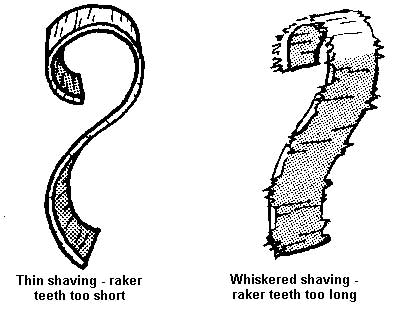Testing a Saw
Make a cut in an average log. A properly running saw cuts without jumping or catching, doesn't bind, makes a straight cut, and makes thick shavings without "whiskers."
Jumping or catching is most often caused by a raker out of adjustment. Check the shavings. If a raker is too long (high), the shavings will have whiskers. The most likely cause of a high raker is overfiled cutters. To correct a high raker, lay the raker gauge lightly over the raker and file it down. Use as little pressure as possible so the points of the cutter teeth in contact with the raker gauge are dulled as little as possible.
If most shavings have whiskers on just one side, either the filing plate on the raker gauge is not square to the plane of the saw (resulting in an unsquare raker cutting edge) or the file in the jointer was not square to the plane of the saw (resulting in the cutter teeth on one side being longer than the other). The solution is either refile the saw after correcting the tool problem or use the saw as is.
If the saw cuts hard and pulls whiskered shavings, the rakers are too long (too little raker depth).
Examining shavings for sharpening
problems

If thin, papery shavings are pulled, the rakers are likely too short. To check further, push down hard on the saw while cutting. If this does not produce thicker shavings with whiskers, the rakers are probably too short. Another test is to saw a small pole or to saw so only a few teeth contact the wood. If whiskers are not produced, the rakers are too short.
Another cause of a catchy or jumpy saw is uneven set.
Binding can be caused by too little set or a curving cut.
A curving cut can be caused by several things: a kinked saw, too much set allowing the saw to flop in the cut, uneven set that pulls the saw to one side, or a sawyer bending or twisting the saw as he cuts (not a fault of the saw, but a problem that might be blamed on the saw).

